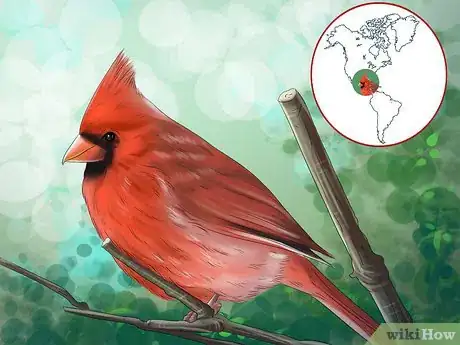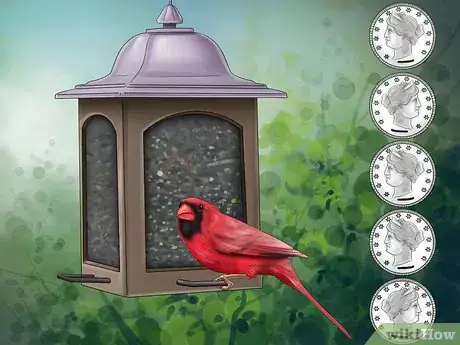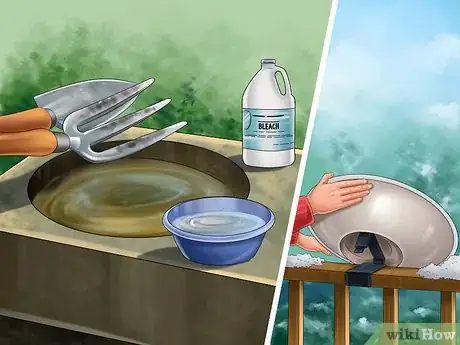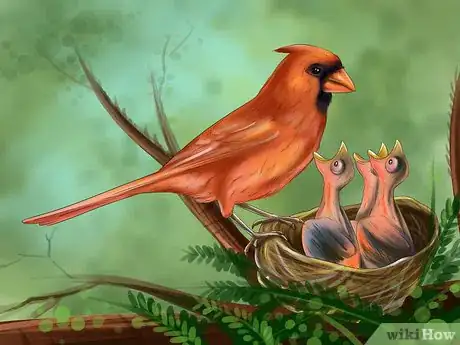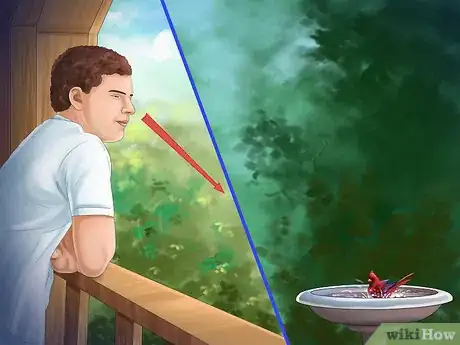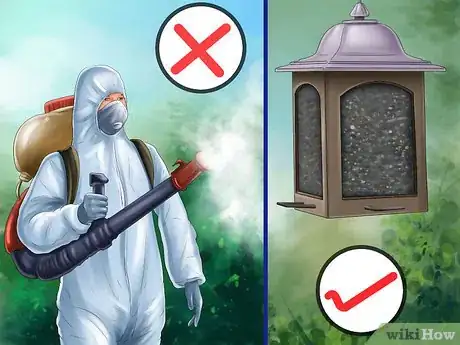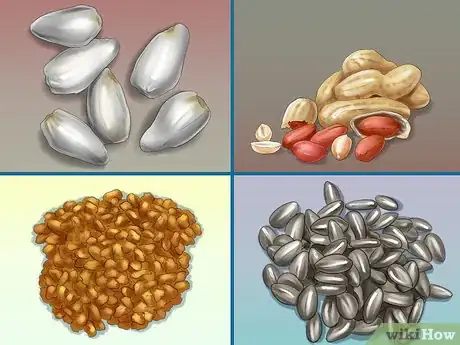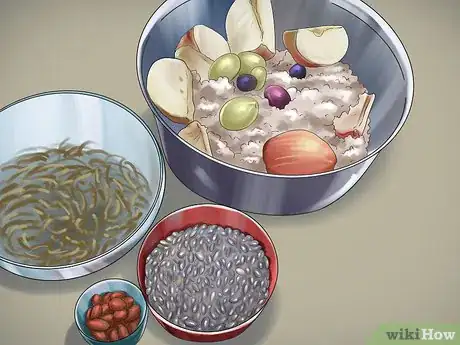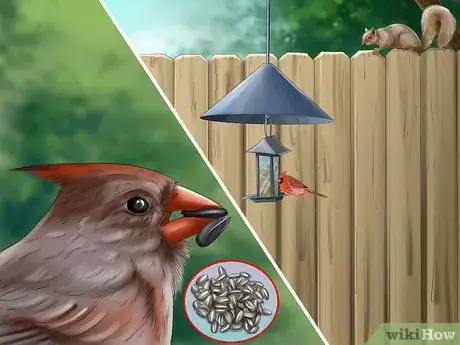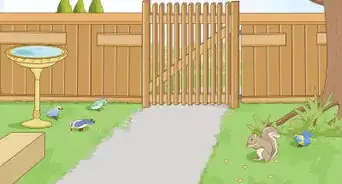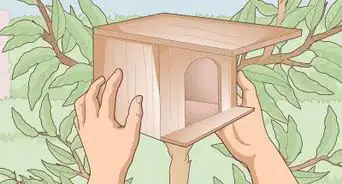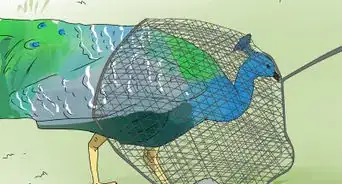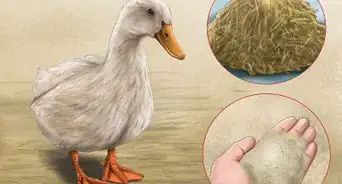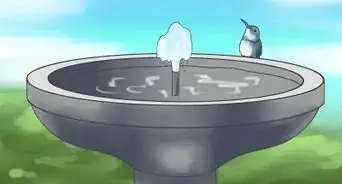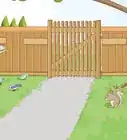This article was co-authored by Roger J. Lederer, PhD. Dr. Roger Lederer is an Ornithologist and the founder of Ornithology.com, an informative website about wild birds. Dr. Lederer has spent over 40 years teaching, studying, and writing about birds. He has traveled to over 100 countries to study birds. Dr. Lederer is an Emeritus Professor of Biological Sciences at California State University, Chico, and has been a Department Chair of Biological Sciences and Dean of the College of Natural Sciences. He has written more than 30 research papers and 10 books on birds and a textbook entitled “Ecology and Field Biology.” Dr. Lederer has consulted the BBC, National Geographic, National Public Radio, ABC News, the Guinness Book of World Records, and numerous other organizations and publications.
wikiHow marks an article as reader-approved once it receives enough positive feedback. This article received 21 testimonials and 88% of readers who voted found it helpful, earning it our reader-approved status.
This article has been viewed 281,930 times.
Cardinals are a wonderful species to see in your yard, especially in the winter, when their bright red color contrasts so nicely with white snow. If you live in eastern North America, and you are not seeing enough cardinals in your yard, you can attract them with very little effort. If you provide adequate food, shelter, and water for cardinals, they are likely to visit your home often and enthusiastically.
Steps
Making Your Yard Attractive to Cardinals
-
1Make sure cardinals are native to your area. Northern cardinals are found throughout eastern and central North America from southern Canada into parts of Mexico and Central America. These birds live as far north as Maine or Nova Scotia, Canada down south through Florida and the Gulf Coast. They range as far west as South Dakota, Nebraska, and Texas.[1]
- Cardinals have also been introduced to California, Hawaii, and Bermuda.
- Northern cardinals do not migrate so they live in the same place year-round.
-
2Buy a bird feeder. Cardinals prefer stationary or platform feeders over a hanging variety. Make sure the feeder is sturdy enough to handle the weight of a cardinal (which is equal to 9 US nickels) and that the perches are long enough for the birds to fit on them.
- Cardinals also like to have cover near feeders, so place it close to trees or shrubs that the birds can flee to if they are frightened.[2]
- Make sure the bird feeder is mounted at least 4–5 ft (1.2–1.5 m) off the ground to protect the birds from predators and other animals.[3]
- Cardinals like areas with dense foliage and high perches but usually stick to the edges of forests. Suburban landscaping and common backyard trees and scrubs are usually attractive habitats to cardinals.[4]
Advertisement -
3Provide water. Place a bird bath a few meters away.[5] Bird baths do take a bit of upkeep to keep them clean and attractive to birds. Clean the birdbath every week or more often if used heavily.
- Scrub the bird feeder with a stiff brush, rinse it with cold water, and then refill it.
- If you have a buildup of algae or scum on the birdbath, use a mixture of one part chlorine bleach to nine parts water to clean the bath.
- Rinse thoroughly before refilling the bath with fresh water.
- If you live in an area where it freezes in winter, a heated birdbath will be very popular with your cardinals.
-
4Make sure there are places for cardinals to nest in your yard. Cardinals will not nest in nesting boxes, so you just need to make sure there are natural places for the birds. They like thick trees, thickets, or shrubs, where they can nest between 3 and 20 feet off the ground.
- Food and water don't need to be really close to the potential nesting area, but should be relatively close.
- For instance, if the thick shrubs are in the back of your house and the food and water are in the front, it should be ok.
-
5Watch for cardinals in your yard. Cardinals feed most heavily in the morning and evening, so keep track of their daily visits for maximum viewing. They shouldn't be hard to spot, due to their beautiful, brilliant color.
- Male and female cardinals look different.
- Male cardinals are typically bright red overall, with a black ring around the beak.
- Female cardinals are usually predominately brown, with bright red bills and a red crest on the top of their heads.[6]
-
6Keep your yard free of predators and harmful chemicals. Keep household pets away from feeders, birdbaths, and nesting areas. Avoid using deadly poisons, such as herbicides, insecticides, or fertilizers, in the vicinity of your feeders and birdbaths. Lawn-care chemicals, for instance, are known to contaminate bird food and water and kill all types of songbirds.[7]
- Help cardinals by eliminating the reflection on your windows near feeding or nesting areas.
- Cardinals are known to fly into windows, which can seriously injure or kill them.
- Install bird netting, awnings, window screens, or flash tape on the outside of your windows to help cardinals avoid crashing into your windows.[8]
Feeding Cardinals
-
1Put sunflower or safflower seeds in your feeder. Black Sunflower seeds are a favorite of cardinals. However, cardinals also like safflower seeds and white milo.
- If you are concerned about litter from seeds, buy hulled sunflower seeds.
- Just make sure to change hulled seeds more often, since they go bad more easily than seeds with shells.
- Cardinals like large seeds. They will eat smaller seeds if nothing else is available, but they prefer large seeds, such as sunflower, safflower, peanuts, or cracked corn.
-
2Put a suet feeder out in winter to provide birds with extra energy. Suet is essentially a block of animal fat mixed with seeds. While this will probably not be the primary feeding choice of cardinals in your area, they may come to a suet feeder to find extra food in the winter.
- Only offer suet in colder months. If it gets too hot, it can melt and go rancid.
-
3Put food on the ground as well. Cardinals are actually ground feeders, so they will happily eat off the ground.[9] If you have a patch of ground that is away from low bushes or shrubs, where predators may hide, you can also scatter seed there.
Expert Q&A
-
QuestionWhere should I put my bird feeder?
 Roger J. Lederer, PhDDr. Roger Lederer is an Ornithologist and the founder of Ornithology.com, an informative website about wild birds. Dr. Lederer has spent over 40 years teaching, studying, and writing about birds. He has traveled to over 100 countries to study birds. Dr. Lederer is an Emeritus Professor of Biological Sciences at California State University, Chico, and has been a Department Chair of Biological Sciences and Dean of the College of Natural Sciences. He has written more than 30 research papers and 10 books on birds and a textbook entitled “Ecology and Field Biology.” Dr. Lederer has consulted the BBC, National Geographic, National Public Radio, ABC News, the Guinness Book of World Records, and numerous other organizations and publications.
Roger J. Lederer, PhDDr. Roger Lederer is an Ornithologist and the founder of Ornithology.com, an informative website about wild birds. Dr. Lederer has spent over 40 years teaching, studying, and writing about birds. He has traveled to over 100 countries to study birds. Dr. Lederer is an Emeritus Professor of Biological Sciences at California State University, Chico, and has been a Department Chair of Biological Sciences and Dean of the College of Natural Sciences. He has written more than 30 research papers and 10 books on birds and a textbook entitled “Ecology and Field Biology.” Dr. Lederer has consulted the BBC, National Geographic, National Public Radio, ABC News, the Guinness Book of World Records, and numerous other organizations and publications.
Ornithologist Put the feeder close to trees or bushes. That way, the birds have somewhere to hide if they feel threatened. Also, if the feeder is near a window, make sure it's not directly in the birds' flight path so they don't accidentally crash into the glass.
Put the feeder close to trees or bushes. That way, the birds have somewhere to hide if they feel threatened. Also, if the feeder is near a window, make sure it's not directly in the birds' flight path so they don't accidentally crash into the glass.
References
- ↑ http://www.biokids.umich.edu/critters/Cardinalis_cardinalis/
- ↑ Roger J. Lederer, Ph.D. Ornithologist.
- ↑ Roger J. Lederer, Ph.D. Ornithologist.
- ↑ http://www.allaboutbirds.org/guide/Northern_Cardinal/lifehistory
- ↑ Roger J. Lederer, Ph.D. Ornithologist.
- ↑ http://www.allaboutbirds.org/guide/Northern_Cardinal/id
- ↑ http://www.fws.gov/migratorybirds/newreportspublications/pamphlet/prob.html
- ↑ http://www.fws.gov/migratorybirds/newreportspublications/pamphlet/prob.html
- ↑ http://www.songbirdessentials.com/page.php?p=1374
- ↑ Roger J. Lederer, Ph.D. Ornithologist.
- ↑ http://www.fws.gov/migratorybirds/newreportspublications/pamphlet/prob.html
About This Article
To attract cardinals, set up a stationary or platform bird feeder and fill it with black sunflower seeds, which cardinals love. You can also scatter some of the seeds on the ground since cardinals are ground feeders. Also, put a bird bath nearby so that cardinals have somewhere to clean themselves. You can even install a heated bird bath, which will attract lots of cardinals during the cold winter months. For more tips on attracting cardinals, like keeping your yard free of predators, read on!
